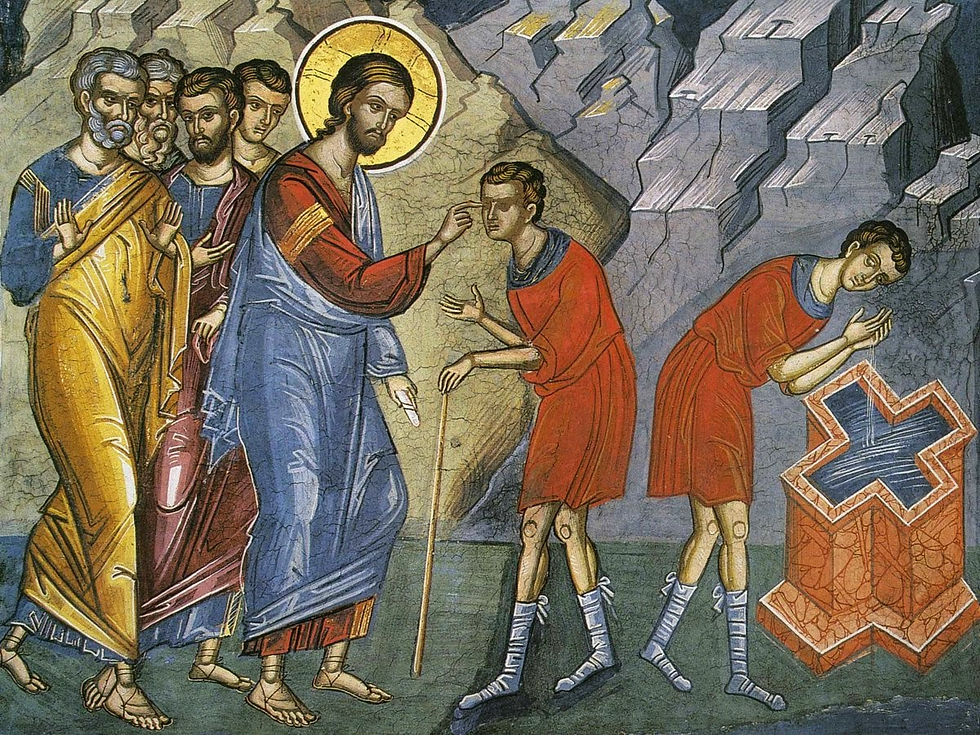The Blind Man at Siloam
- Fr. Scott Haynes

- Aug 10, 2021
- 3 min read
Fr. Scott A. Haynes
“When He had thus spoken, He spat on the ground, and made clay of the spittle, and He anointed the eyes of the blind man with the clay, and said unto him, Go, wash in the pool of Siloam, which is interpreted, Sent. He went his way therefore, and washed, and came seeing.” (John 9:6-7).
Reading this passage, we note that Jesus did not stop with words (“When He had thus spoken”), but at once added the deed (“He spat on the ground, and having made clay, He anointed the eyes of the blind man”). By using the clay, the Lord showed that it was He Who formed Adam out of clay. Earlier He announced, in so many words, “I am He Who formed Adam” (which offended the Jews since they believed Jesus was blaspheming); now He demonstrates with an irrefutable deed the truth of who He is, Our Lord and Creator.

Jesus created eyes for the blind man out of clay, just as He had done for Adam. He did not merely fashion the eyes, or open them, but gave them vision. This proves that it was He Who breathed the soul into Adam. Without the soul being present to impart its divine energy, even a perfectly formed eye would see nothing.
Christ used spittle to make him see, because He was about to send the blind man to the pool of Siloam and wanted to make clear that He, not the water of that spring, was the source of the miracle. Let us learn that He fashioned and opened the man’s eyes by the power which proceeds from His mouth; this is why He spat on the ground to make clay. Then, lest anyone imagine that the source of the miracle was the earth, He ordered the man to wash off the clay. Some say that the clay was not removed, but was fashioned into eyes.
Why does Jesus command him to go to the pool of Siloam? First, that we may learn of the blind man’s faith and obedience. He did not reason, “If the clay and the spittle which will give me eyes, why must I wash in the pool of Siloam?” but obeyed the One Who commanded. Second, with this order, the Lord confounds the Jews who willfully rejected Him. It is likely that many saw Him anoint the man’s eyes with clay and paid close attention to what He was doing. As a result, no one could later dispute that the Lord had done these things. Third, by sending the blind man to the pool of Siloam, Christ shows that He is not an opponent of the Old Testament.
Why does the Evangelist add the interpretation of the word “Siloam”? So that you might learn that the pool of Siloam is a figure of Christ, and that it was Christ Who healed the man there. Just as Christ is the spiritual Rock, so is He the spiritual Siloam. As the gush of the spring of Siloam was fearful in its strength, so too the coming of the Lord, hidden and unknown to the angels, overwhelmed all sin by His mighty power.
The blind man whom Jesus saw (Jn. 9:1) therefore represents all men. He was unable to see his Creator, so God Himself, the Dayspring from on high, through His tender mercy visited him (Lk. 1:28). And how does He heal their blindness? By spitting on the ground and making clay. Consider how the Word became Flesh. The Holy Spirit descended upon the holy Virgin like a rain-drop falling upon the ground (see Ps. 71:6), and anointed the eyes of the mind with clay made from spittle and the earth. This clay is the one Christ with His two natures—the divine nature, symbolized by the rain-drop falling from the heavens, and the spittle, and the human nature, symbolized by the earth from which came the body of the Lord.
Do men receive healing merely by believing? Certainly not: they must first go to Siloam, which is the spring of Baptism, to be baptized into Him Who sends them there, namely, Christ. For as St Paul says in Gal. 3:27: For as many of us as have been baptized have been baptized into Christ. Thus, this Gospel lesson reminds us of our baptism, how our spiritual blindness and all original and actual sin is washed away by the waters of baptism.



Comments